Winging It
By Samantha Jones, communications intern on November 14, 2018 in Blog
%20Raymond%20Barlow--AKM%20Images%2C%20Inc.jpg)
Iowa is home to an impressive array of bird species, including owls. While some species only visit Iowa during their migratory treks, others live year-round in the state. To celebrate National Geographic’s Year of the Bird, learn more about the nine owl species that call Iowa home.
%20Raymond%20Barlow-AKM%20Images%2C%20Inc_.jpg) |
| Photo by Raymond Barlow, AKM Images |
Barn Owl
State Endangered
Barn owls are medium-sized with a heart-shaped face and brown eyes. Their head, back and the upper part of their wings are buff and gray while their face, body and underwings are white. Barn owls like to nest in dark, secluded spaces — typically tree cavities, caves, cliff ledges and in abandoned buildings and barns. With the disappearance of grasslands and wetlands in Iowa, Barn owls are losing much of the grassland habitat they use to hunt for prey. Listen for their distinctive call: They don’t hoot like most owls, but instead make a long, harsh screech.
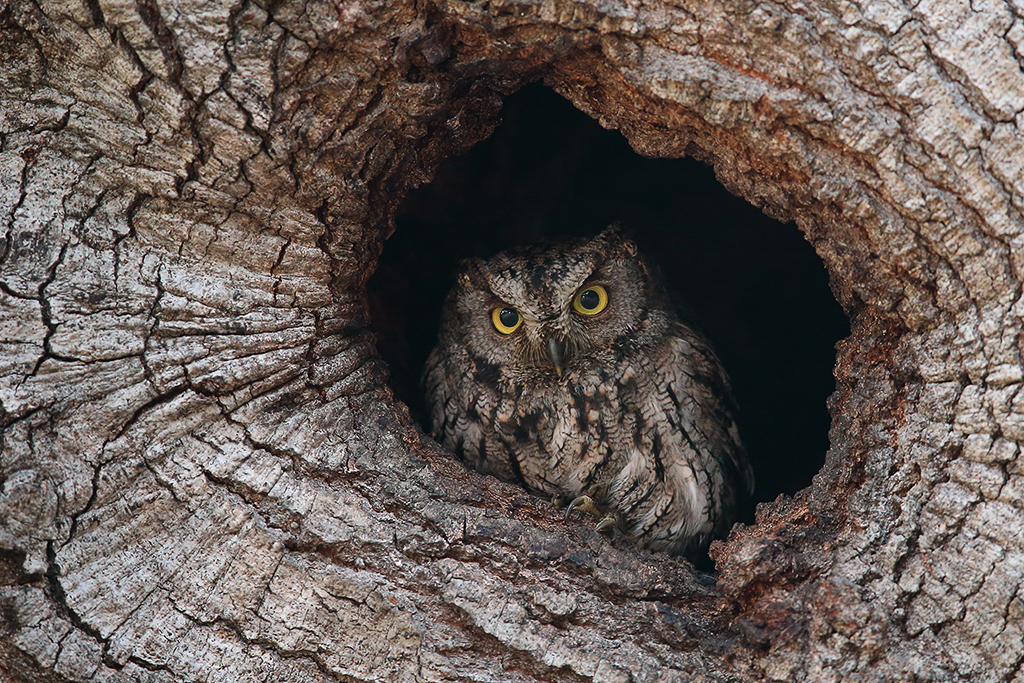 |
| Photo by Raymond Barlow, AKM Images |
Eastern Screech Owl
Common
The Eastern screech owl is the smallest permanent resident owl in Iowa — about the size of a robin. It is either gray or reddish-brown, with complex patterns that camouflage well with foliage and tree bark. The Eastern screech owl’s ear tufts are often raised, giving it a distinct silhouette. Unlike its name suggests, the screech owl rarely screeches — instead, its calls mainly consist of soft, low hoots or trills. The Eastern screech owl can be extremely difficult to find, especially during the daytime when its feathers camouflage it almost perfectly amongst the dense woodland cover it sleeps in.
%20Raymond%20Barlow-AKM%20Images%2C%20Inc_.jpg) |
| Photo by Raymond Barlow, AKM Images |
Great Horned Owl
Common
Great horned owls are large, thick-bodied birds with prominent tufts on the top of their heads. Their bodies are a mottled gray-brown color, with tan faces and a white patch on their throat. Great horned owls typically live in wooded areas, particularly those interspersed with open spaces. Instead of building their own nests, they occupy nests built by other animals such as hawks and squirrels, laying eggs and raising their young there. They eat a wide variety of species — some larger than themselves — including rabbits, squirrels, skunks and other owls. Great horned owls are adaptable and can be found in cities and suburban neighborhoods in addition to rural areas all across the state. Most are permanent residents of Iowa, but some may migrate to warmer locations in winter.
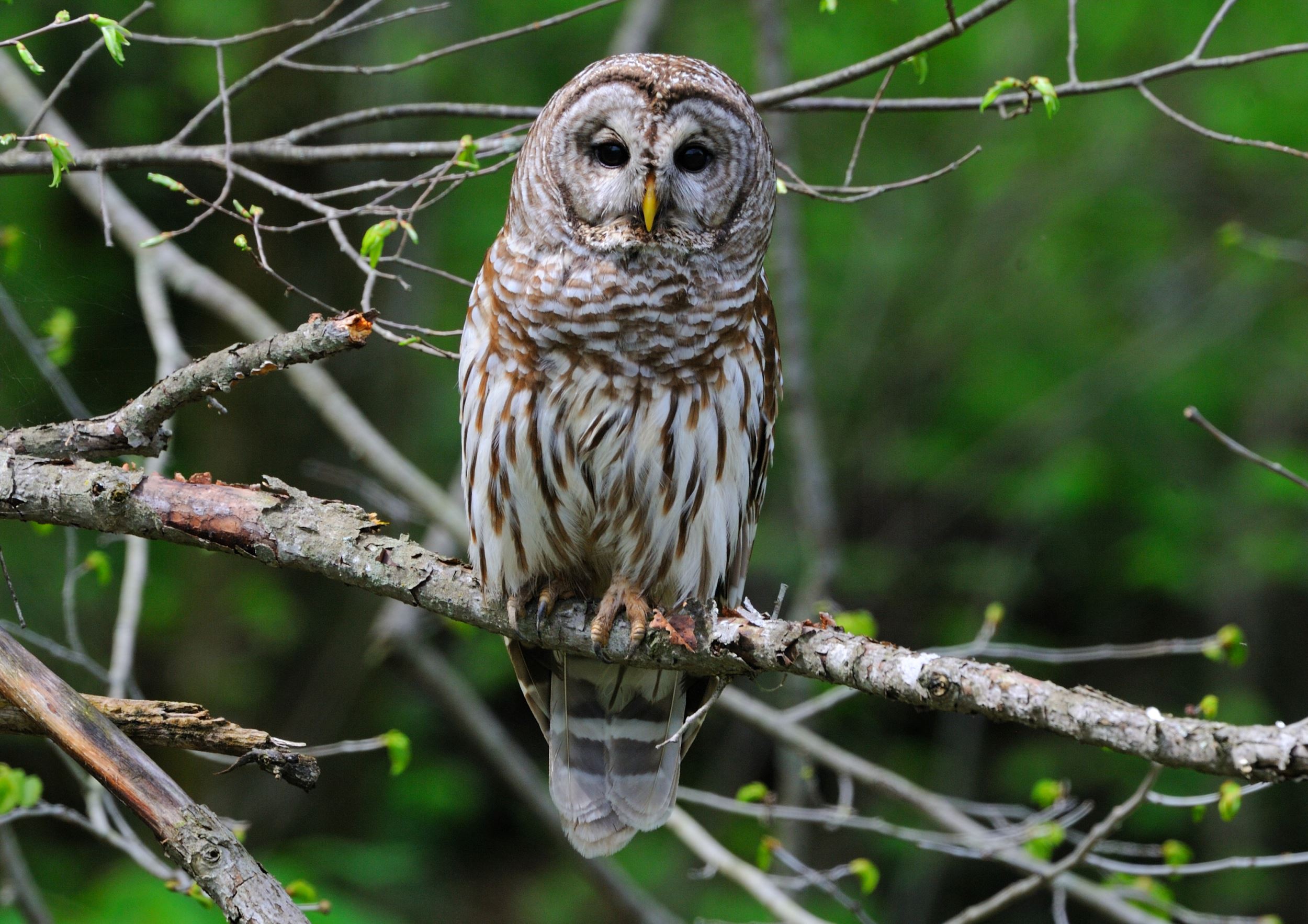 |
| Photo by Ron Huelse |
Barred Owl
Common
Barred owls are mottled brown and white with dark eyes and brown and white stripes on their wings and tail. A little smaller than the Great horned owl, the Barred owl has a rounded head with no ear tufts. They live in mature forests, particularly those with both deciduous and evergreens, often nesting in locations near a water source. They eat mice, voles and occasionally other birds. Listen for their barking “who cooks for you?” call — it may sound like a large dog from a distance. During the day, you may get lucky and spot one roosting in a tree.
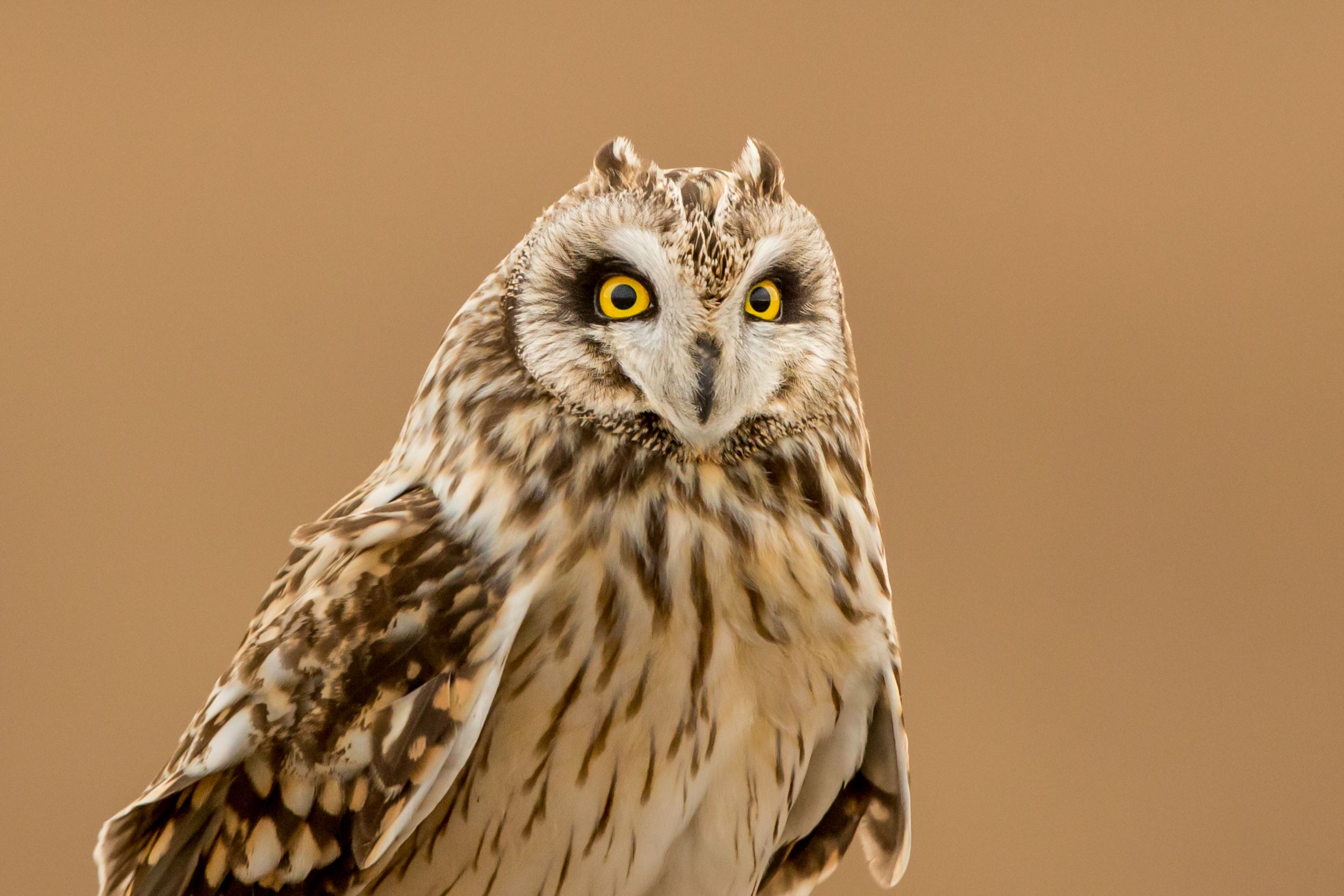 |
| Photo by Eric Williamson |
Short-Eared Owl
State Endangered
Short-eared owls are medium-sized owls, with rounded heads and tiny “ears” — in reality, small tufts of feathers. The Short-eared owl is spotted brown with buff and white on its upper parts. Its face is pale with yellow eyes surrounded by black outlines. These owls live in grasslands and open spaces, perching on low trees or on the ground. During daylight, the Short-eared owl hunts by flying low over the grass to look for rodents. They’re most often spotted in winter, either sitting on the ground or flying low as they hunt for prey. They often fly in a crisscross or circular pattern, so if they disappear out of sight, don’t give up — they may reappear soon.
%20Raymond%20Barlow-AKM%20Images%2C%20Inc_.jpg) |
| Photo by Raymond Barlow, AKM Images |
Long-Eared Owl
State Endangered
Long-eared owls are slender, medium-sized owls with long ear tufts that stick straight up and large yellow eyes. The coloring on its wings and body is a complex black, brown and buff pattern, and its facial disks are an orange or buff color. While Long-eared owls hunt and forage in grassland or open spaces, they require dense shrubs for nesting and roosting. During winter, Long-eared owls roost in large groups, making them easier to spot. Look on the ground for gray, cylindrical owl pellets around the bases of dense pine trees — this may be a roosting site.
%20Raymond%20Barlow--AKM%20Images%2C%20Inc.jpg) |
| Photo by Raymond Barlow, AKM Images |
Northern Saw-Whet Owl
Uncommon
Northern saw-whet owls are only eight inches tall, with large heads and catlike yellow eyes. Their feathers are mottled brown and white with white streaks on their head and a distinctive white “V” between their eyes. They live in dense forests, typically nesting in the cavities of cedars and other coniferous trees during the winter. Listen for their sharp, rhythmic “too-too-too” call on quiet nights in forests, or watch for songbirds — they will kick up a racket if they discover a roosting Saw-whet.
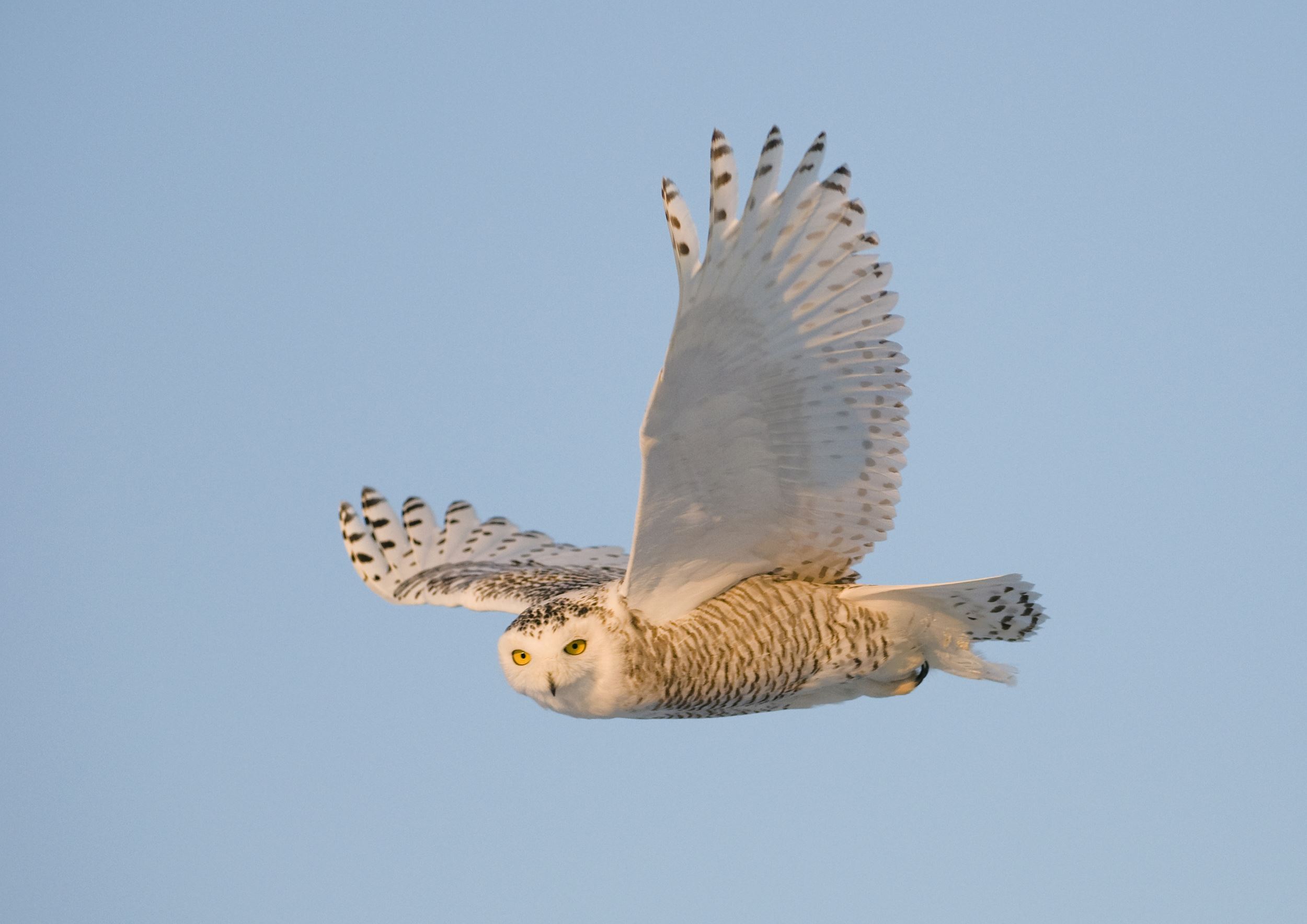 |
| Photo by Raymond Barlow, AKM Images |
Snowy Owl
Rare
This owl is the heaviest North American owl with mostly bright white plumage and sporadic brown spots. Its head is rounded with no ear tufts, and it has dense feathering on its legs. Snowy owls breed in the arctic tundra, but occasionally visit Iowa in winter. If you’re extremely lucky, you might see one along lake shorelines, in agricultural fields or in open spaces.
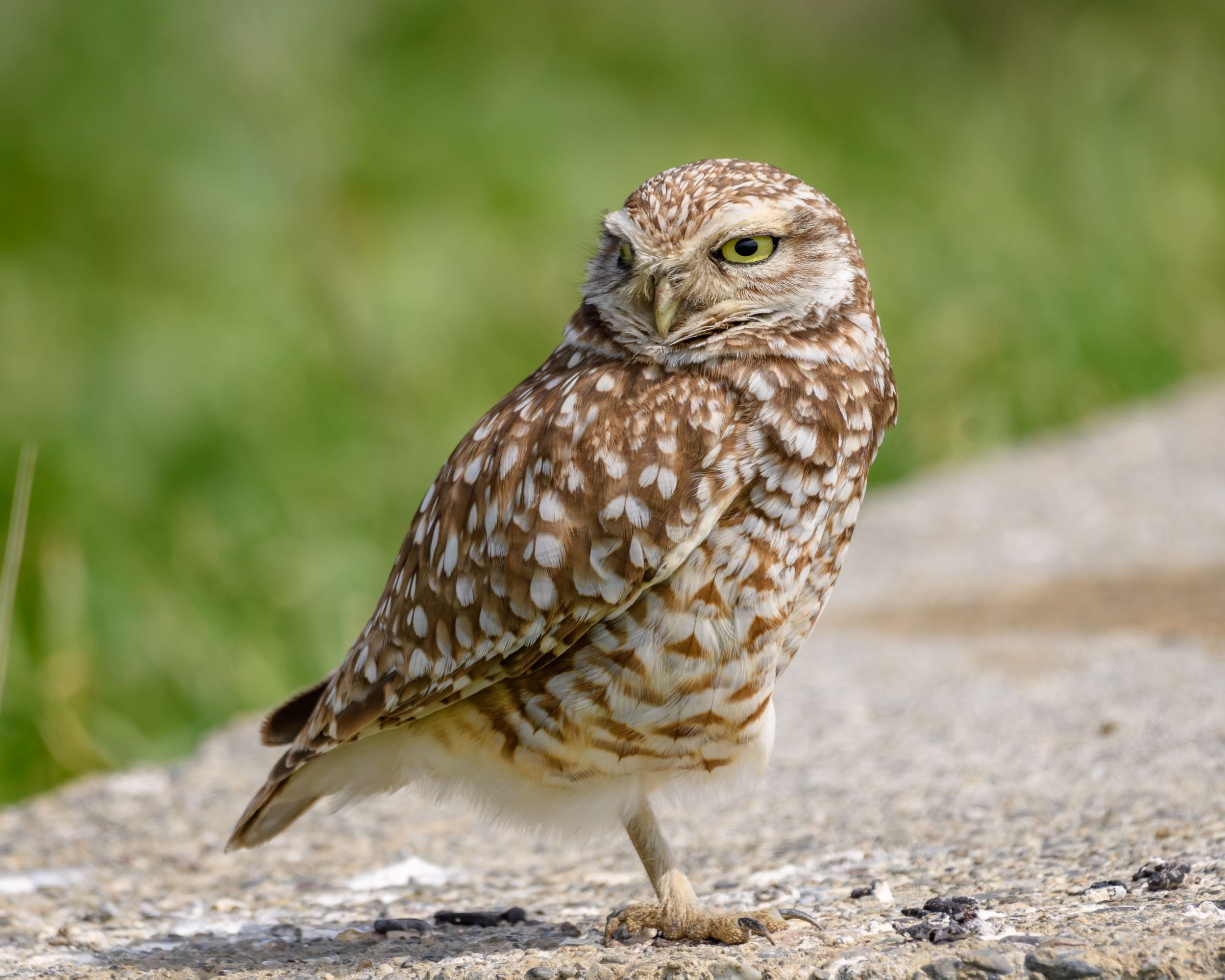 |
| Photo by Becky Matsubara |
Burrowing Owl
Rare
This owl is small and long-legged with mottled brown and white feathers, yellow eyes and a yellow bill. The head is rounded with no ear tufts. A very rare nester in Iowa, Burrowing owls live in open spaces with sparse vegetation, hunting close to the ground for insects and small animals. They primarily nest in ground burrows made by badgers. Pay attention to burrow entrances in wide-open areas, where they will often stand when not hunting. These owls tend to be most active in early morning and late evening.